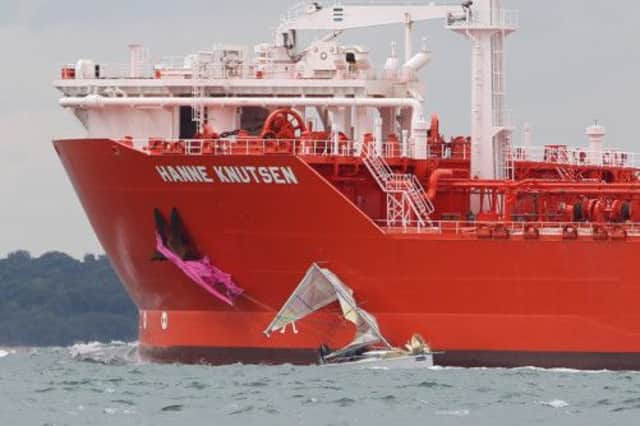Racing yacht ‘perilously close’ to oil tanker


Roland Wilson, 32, from Stanley in Perthshire, is alleged to have been negligent after his boat, Atalanta of Chester, was involved in the collision which took place on the first day of the Cowes Week racing regatta in August 2011.
Footage of the incident, in which one crew member suffered head injuries and another abandoned ship, has been posted on YouTube.
Advertisement
Hide AdAdvertisement
Hide AdWilson, who was a serving RN officer at the time of the accident but who is now an RN reservist, denies three counts of contravening maritime regulations at the trial being held at Southampton Magistrates’ Court.
Charles Row, prosecuting, described how Wilson, who owned and
skippered the 33ft racing yacht, which had a crew of eight, into the path of the 260m-long (853ft), 42m-wide (138ft) Hanne Knutsen tanker despite having seen it from about five miles away.
He said: “The sea was calm, visibility was excellent, in excess of 10 miles (16km), with 10 to 12 knots of wind.
“Unfortunately, despite these favourable conditions, the Atalanta was towards the back of the race, nevertheless she was making seven knots.”
Mr Row said that Wilson failed to comply with local shipping by-laws which required him to maintain a moving prohibited zone (MPZ) of 1,000m (0.6 miles) in front and 100m (328ft) either side of a vessel greater than 150m (492ft).
He described how the situation became more complicated by a small motor vessel called Joy C which suffered engine failure just to the starboard of the Hanne Knutsen, which was heading to Fawley oil refinery.
Horn
The Hanne Knutsen had initially sounded its horn to indicate a
Advertisement
Hide AdAdvertisement
Hide Adstarboard turn which it then abandoned when its pilots spotted the Joy C’s plight.
The tanker then sounded its horn again to indicate it was actually going to make a port turn.
It was shortly after this that the accident happened.
Mr Row said that even though the Hanne Knutsen started to change its course, the Atalanta should not have been in such a close position to the tanker.
He said that Wilson failed to turn on the Atalanta’s engines to power away from the tanker in order to avoid the collision.
He said that such action was permitted under the race rules and would not have led to disqualification.
Mr Row said: “She was still attempting to manoeuvre under sail power alone.
“She too had stopped in the water with her sails flapping, they found themselves in the wind shadow of the Hanne Knutsen.
“One of the crew took the decision to abandon ship approximately five or six seconds before the collision.
“He passed down the starboard side of the Hanne Knutsen.
Advertisement
Hide AdAdvertisement
Hide Ad“Having abandoned ship he was picked up by a spectator vessel.
“The Atalanta mast struck the bow of the Hanne Knutsen and was pivoted round to the port.
“She was dismasted and one of her crew suffered head injuries which required hospital treatment.
“Mercifully there was no other injury as a result of what happened.”
Mr Row continued: “The Atalanta was passing perilously close even assuming that nothing went wrong, (it was) banking on the Hanne Knutsen turning at a certain rate at a certain point but something did go wrong.
“The Joy C found itself at great peril in front of the tanker, this caused the Hanne Knutsen to delay its turn.
“The Atalanta was in the MPZ having sailed hard.
“We say the MPZ is there for a reason, it’s there to allow for a margin of error, it’s a safety zone.
“The Atalanta had not turned on its engine so didn’t have the power to manoeuvre when it did lose its wind and it ended up stalling.” District Judge Anthony Calloway, who is hearing the trial, was shown what Mr Row described as the “infamous YouTube footage”.
Footage
Advertisement
Hide AdAdvertisement
Hide AdThe footage shows the Atalanta, which had a bright pink sail, cross the path of Hanne Knutsen and crash into its side, knocking its mast off.
Screams can be heard from spectators who saw the incident happen.
Mr Row stated that Wilson said in interview he had no formal sailing qualification but had been racing for eight years.
He said that Wilson knew and understood the sailing regulations and admitted that he was “obliged to keep out of the way” of the tanker.
Mr Row said that the tanker’s horn blast indicating its starboard turn, which was then countermanded to a port turn, had lead to the collision.
He said: “This led them to believe it was going to turn to starboard and it seems they relied on that.”
He added that Wilson claimed: “It was only that manoeuvre of heading to port that placed the Atalanta in the MPZ.”
Mr Row added that Wilson blamed the pilots for the accident because of the “confusing” horn blasts.